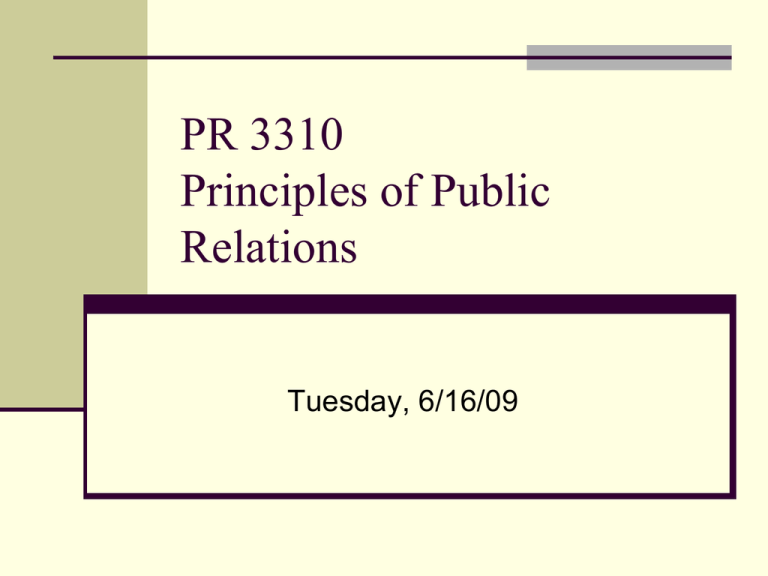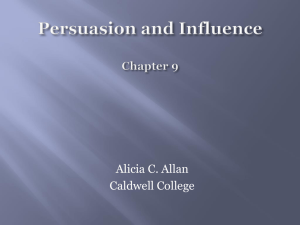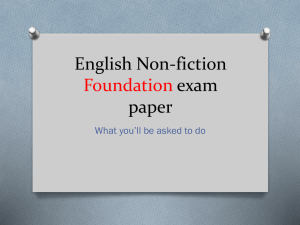Public Opinion and Persuasion
advertisement

PR 3310 Principles of Public Relations Tuesday, 6/16/09 Class Objectives Presentations: S. Campus and K. Black Lecture Ch. 9, Public opinion Homework assignments Presentations tomorrow: C. Gallagher and A. Fanning Read chapter 9 in book, not covering theories Paper 2 due on Thursday 6/18 at 12:05 pm What’s in the news today The Indonesian government is sponsoring a national campaign promoting honesty (country is widely known to be corrupt in many ways) http://www.nytimes.com/2009/06/16/w orld/asia/16indo.html Opening up “cashier free” honesty cashier-free “honesty cafes” (7000 so far), in schools and gov’t offices The attorney general’s office says the honesty cafes will halt corrupt tendencies among the young and straighten out those known for indulging in corrupt practices PR aspect: persuade from the bottom up, preventive measure rather than reactive What’s in the news today Twitter and Facebook get serious for the opposition group in Iran, a case of cyber activism http://www.nytimes.com/2009/06/16/world/middleeast/16media. html?_r=1&hp The Iranian government has blocked texting and cell transmissions, has (today) limited the news coverage, but is having a hard time blocking posts to Twitter and Facebook Too many ways to originate a post (by cell phone, web site, or specialized applications) Too many ways to post new content (like a whack-a-mole game) Can use a proxy/mirror site PR aspect: a new way for an activist group to assemble protests, speaking events Public Opinion Opinions on controversial issues that one can express in public and not isolate themselves Unless you’re in the Borat/Bruno movie Public opinion consists of multiple individual opinions Different groups may agree on a goal but disagree on a method to achieve the goal Public opinion is that childhood obesity is a problem Ban McDonald’s from selling Happy Meals Further restrict items that can be purchased with food stamps Assumptions with Public Opinion 1. That an audience is normally passive and tends to follow Therefore public opinion may be expressed by a small and highly vocal group 2. That those with no interest in a topic do not contribute to public opinion 3. That events of unusual magnitude swing public opinion from one extreme to another Need time away from event to stabilize public opinion Ex. from book is 9/11 Stages of Public Opinion 1. Form opinion, define it, take a side 2. Involvement of leaders (more about this later) 3. Public awareness grows 4. Possible Government regulation (passing of laws, re-count of votes…) 5. Resolution (actions, passage of time to change opinion) Public Opinion, who is your audience Look at them in terms of demographics, but psychographics is better (with public opinion) What is their lifestyle and behaviors? Can we group them under categories? Pew reported a groups of people who use technology Link to 14 item survey: http://pewinternet.org/Participate/What-Kind-of-TechUser-Are-You.aspx Groups, http://pewinternet.org/Reports/2009/5-TheMobile-Difference--Typology.aspx?r=1 PR should tailor the message for these different groups Public Opinion Opinion is determined by self-interest Opinion is not easily changed Opinion is not aroused for long periods of time Again, it’s a collective opinion Opinion is highly sensitive to events that have an impact On health of people, safety, security, etc. Normally public opinion does not anticipate an event, it reacts to it Opinion Leaders Informed people that others assume are experts on the topic and can clearly articulate their views Formal opinion leaders are voted into position or have title (e.g. President, CEO, etc.) Informal opinion leaders have clout for some other reason May be role models (sports figures, celebrities) May have a following and can therefore exert peer pressure on them (Twitter’s suggested users) Opinion Leaders PR publicists attempt to sway opinion leaders just as they do journalists, other media gatekeepers, and the public at large Journalists will ask opinion leaders what they think (use as a source in their story) Many consider opinion leaders “visionaries” in their field Opinion leaders filter information provided by mass media to their followers, who communicate it to their peers Domino effect Faberge shampoo… http://www.youtube.com/watch?v=TgDx WNV4wWY Mass Media The dissemination of the opinion leaders’ views spreads fastest through mass media channels Traditional outlets are radio, tv, newspapers, magazines New outlet is the Internet With mass media, you can rapidly communicate with millions of people Versus 1-to-1 Pr publicists are providing content to the mass media; some say up to ½ of the information carried in mass media comes from PR sources Can include background information on a person, information on a new product, arranging an interview with a local sports hero, providing statistics and numbers about your client Role of Mass Media By selecting which types of messages they will report (and what stories to write), they trigger public discussion on issues They help form an opinion for those with no background Remember, public opinion consists of those who have opinions, not the disinterested Goal is to be non-biased in what they are reporting, however… With tv, radio, you hear the tone and/or comments made about a story Newspapers, Internet appear more objective because there is no “voice” Is the source credible? Persuasion An activity or process where the communicator tries to change a behavior, belief, or attitude in another person We assume the receiver has the freedom to choose to not be persuaded Can be overt or subtle Verbal or non-verbal Can come from friends/family, close contact, or distant (opinion leaders) Persuasion Hardest to try to change a negative opinion into a positive one Peer pressure contributes to the challenges of changing the image Easiest to persuade people who already have some type of self-interest going, and to reinforce a favorable message Is this beneficial to me in some way? Do I already agree with the message? Factors in effective persuasion Audience analysis Source credibility Appeal to self-interest Clarity of message Timing and context Audience participation Suggestion for action Content and structure Persuasive speaking Source Credibility Expertise, sincerity, charisma Depending upon who the source is, the ranking and amount of these factors will change Doctor’s = expertise first Celebrities = charisma first Using celebrities to endorse Positive is high-level exposure, reputation (hopefully good) rubs off onto message Negatives: hard to manage celebrities actions, is very expensive, if celeb has too many endorsements, yours is less effective Appeal to self-interest Again, this is why a psychographic breakdown of your target audience is beneficial I have heard the message and am going to do an action (e.g. donate to a charity), this is because I feel that doing this action will Improve my self-esteem Increase the respect (I have for myself or from others) Increase my wealth Increase my skill set Increase my well being (physical and mental) Ways to persuade with your message Make sure the message is clear and simple Helpful to tell the audience exactly what to do Volunteer at a Boys and Girls Club today Try to have it received during an appropriate time and within an appropriate context Tide truck going to Louisiana after Katrina Create a message that uses statistics, drama/emotional appeals, personal examples Ways to persuade with your message Have speakers delivering your message use various tactics (propaganda pg. 238 in book) Humble beginnings (politicians use a lot) Jump on board (join us in supporting…., every mom wants to know more about…) Testimonials (I’ve tried it and it works!) Package the message various ways Transfer/ associate the message with something of high status (a corporation pays to become a sponsor of the Olympics) Glitter generalities/ associate the message with a favorable abstract idea (freedom, democracy) Use of rhetoric (words) on the name or what to call the message Drilling for independence by the Oil industry Some Technology Terminology Flash mobs: a large group of people who quickly gather in a public place, perform an unusual action for a brief time, then quickly disperse. Actions include pillow fighting, silent disco dancing, blowing bubbles Events are organized by social media (Facebook, twitter, myspace) or viral e-mails Most have been benign in reasons, some political protests Viral Videos Videos that have gained quick popularity through Internet sharing/linking of file (through e-mails, IMming, blogs, other social websites) Often are political, humorous Can be PR campaigns… A PR campaign for a new TV show consisting of a flash mob in a LA store; video on YouTube is now viral http://www.youtube.com/watch?v=vfxCnZ4Dp3c&N R=1 http://www.reuters.com/news/video?videoId=10612 9&videoChannel=6 …Or promote/launch a product Free Hugs campaign video launched the band “Sick Puppies” into stardom http://www.youtube.com/watch?v=vr3x_RRJdd4 How do you monitor public opinion? As with research and getting feedback, you can Make personal visits Look at what the media is reporting Helpful to also look at comments to articles online Pay for a poll, make telephone calls, survey a certain psychographic segment Hire an advisory committee (of opinion leaders or people who’ve been through unique experiences) Video: Coke’s Water Bomb Video on Coca-cola’s PR “disaster” with Dasani drinking water in Britain In 2004, a story broke that revealed that the source of the Dasani water was treated tap water, not a natural spring water source In fact, there was a carcinogenic (a promoter of cancer) in the water after they treated it!



